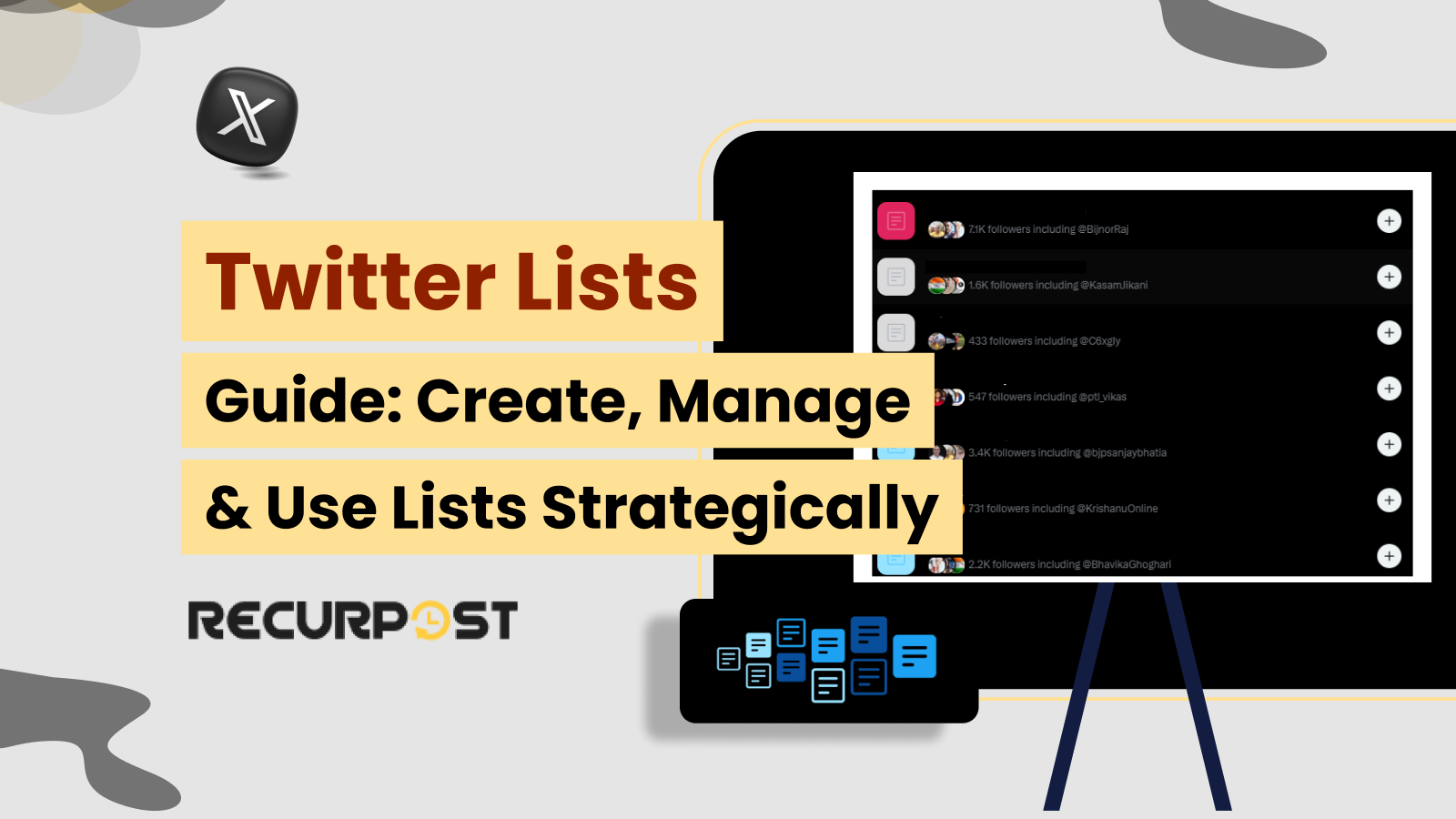Twitter is great, right? But if you’ve ever felt like you’re drowning in tweets or scrolling endlessly to find what matters, you’re not alone. Twitter lists are here to save the day.
A Twitter list is a curated group of Twitter accounts that functions as a custom feed you control, where you see only what you want, like industry news, competitor updates, or even your favorite customers’ latest thoughts.
With Twitter list management, you can organize all that Twitter chaos into neat, tidy groups. Imagine getting the lowdown on clients, keeping tabs on your competitors, or staying plugged into trends, all without the stress of missing a beat. Social media managers, agencies, and small business owners, this is the hack you didn’t know you needed.
Stick around, and I’ll show you how to create Twitter lists, manage them like a pro, and even use them to find leads or spy on (ahem) competitors. Let’s turn Twitter lists into your secret weapon for staying on top of everything Twitter throws at you!
How to Create and Manage Twitter Lists: The Basics
Ready to set up your first Twitter list? Let’s break it down into simple steps.
Step 1: Access Your Twitter Lists
Open up Twitter, head to the left sidebar, and click on Lists. You’ll find all your existing Twitter lists here, plus an option to make new ones. If you’re just getting started, don’t worry, creating a Twitter list is a breeze.
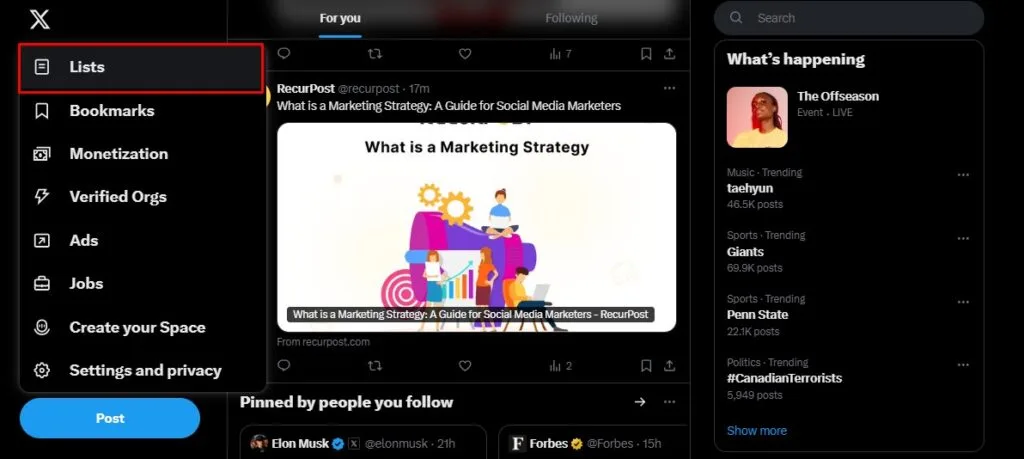
Step 2: Create a Twitter List
Click on Create New List. Creating a Twitter list requires users to complete three simple steps, where Twitter list creation involves naming the list, adding an optional description, and selecting privacy settings.
- List Name: Keep it short and clear. Names like “Top Clients” or “Industry Trends” work well.
- Description (Optional): Add a quick note to remind yourself (and others, if it’s public) what this list is for.
- Privacy: Choose Private if you want only you to see this list, like for competitors. Go Public if you’re making a list for others to follow, like a curated feed of top influencers.
Once that’s set, click Next. You’ve officially created a Twitter list!
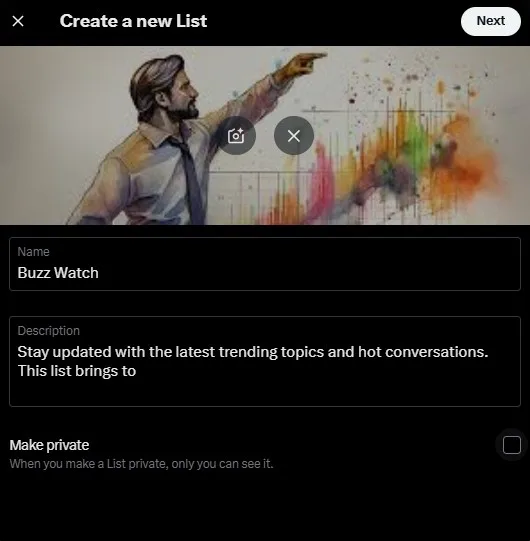
Step 3: Add Twitter Accounts to Your List
Now, let’s fill it up. Go to any Twitter user’s profile, click on the three dots (the handy options menu), and select Add/Remove from Lists. Choose your list to group Twitter accounts together, and you’re good to go. This is where you can really start organizing. You don’t have to follow someone to add them to a list, which is perfect for keeping tabs without crowding your main feed.

Step 4: Managing and Editing Lists
Twitter list updates include editing list names and descriptions, where Twitter list modifications allow users to change privacy settings between public and private while adding or removing members through the Edit List function.
If you’re experiencing Twitter lists not working properly, this is also where you can troubleshoot by updating the name, description, or privacy settings. Need to remove someone? Just go to the Members tab on your list and make your changes.
Using Twitter lists involves organizing accounts by purpose, where Twitter list usage allows users to check list feeds regularly for targeted content while engaging with list members to build relationships and maintain a clean timeline. You can even pin your most important lists to the top of your feed for quick access!
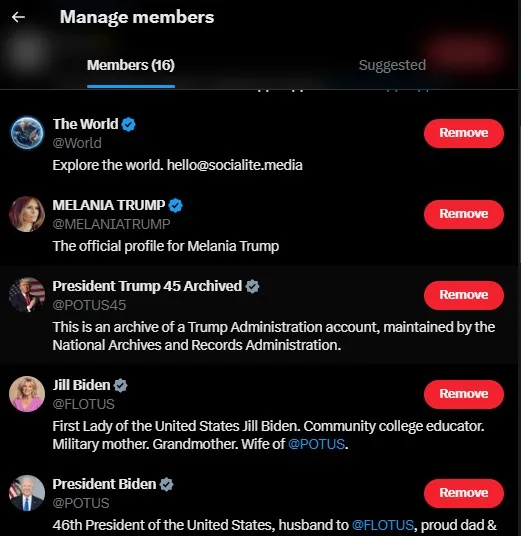
What is a Twitter List Manager?
A Twitter List Manager is the individual (or tool) responsible for overseeing, organizing, and maintaining Twitter lists. They ensure that the lists are updated, members are relevant, and the lists serve their intended purpose effectively.
If you manage multiple lists, hiring or using a tool as a Twitter List Manager can make your social media strategy more efficient. By staying on top of list maintenance, a Twitter List Manager can ensure that your lists remain useful for engagement, lead generation, or content curation.
Some tasks of a Twitter List Manager include:
- Creating and organizing lists: Categorizing accounts based on specific purposes, such as competitors, leads, or industry influencers.
- Regularly updating lists: Adding new accounts, removing inactive users, and adjusting list priorities.
- Monitoring and engaging: Actively engaging with relevant tweets from list members to maintain relationships and boost visibility.
By appointing a Twitter List Manager, either manually or through automation tools, you can optimize your social media strategy while keeping your Twitter feed organized.
Strategic Uses of Twitter Lists for Business Growth
Once you’ve got your Twitter lists set up, it’s time to put them to work. Think of these lists as your own mini-feeds, tailored to help you grow your brand, connect with influencers, and keep an eye on the competition.
Here’s how social media managers, agencies, and small businesses can use Twitter lists to their advantage.

1. Keep Tabs on Competitors (Without Following Them)
Want to watch competitors without giving them a follow? Create a private Twitter list just for them. This lets you see what they’re sharing, their engagement style, and any new strategies they’re testing, all without notifying them. It’s like having a front-row seat to their Twitter feed without joining the fan club.
2. Build a Community of Loyal Customers
Make a public Twitter list of your best customers or brand advocates. Not only does this give them a little recognition, but it also shows other followers you’re paying attention to the people who matter. Customers love to be seen, and this kind of shoutout encourages more engagement.
3. Follow Industry Influencers and Thought Leaders
Want to stay on top of trends? Create a list of industry influencers, experts, and social media stars who share valuable insights. By following your Twitter list feed of influencers, you’ll get all the latest updates without your main timeline getting cluttered. This list becomes a goldmine for content ideas, networking, and even collaboration opportunities.
4. Monitor Important Conversations in Your Field
Use Twitter lists for social listening. Set up lists around specific topics or hashtags examples related to your business, like “Digital Marketing Tips” or “Social Media Implementation.” You can track relevant conversations and jump in when there’s a chance to add value or promote your brand. It’s a great way to stay in the loop and show that your business is plugged into what matters.
5. Curate Content for Your Followers
Public lists let you do some next-level content curation. Create Twitter lists that your followers can subscribe to, like “Top Social Media News” or “Best Marketing Blogs.” This way, you’re providing value beyond your own tweets. Plus, it positions your brand as a helpful resource in your niche.
With these strategies, Twitter lists become more than just an organizational tool. They help you keep track of what matters, engage with your audience, and show up where your social media audience is active. That’s smart Twitter list management in action!
Creative Ways to Use Twitter Lists
Beyond basic organization, Twitter lists offer some clever ways to boost engagement and visibility. Here’s how you can get creative with Twitter lists and make them work even harder for you.

1. Curate Content for a Public List
Public lists aren’t just for you; they’re a resource for anyone on Twitter. If you’re a social media manager or agency, consider creating Twitter lists that highlight top voices in your industry. A list titled something like “Must-Follow Marketing Gurus” or “Local Small Biz Heroes” could attract followers who appreciate the curated feed, giving your brand extra exposure as a go-to source.
2. Showcase Brand Advocates or Team Members
Give your brand’s superfans or employees a moment in the spotlight. By creating a public list of brand advocates or team members, you’re making it easy for others to see what these individuals are sharing and talking about. This adds a personal touch to your brand and encourages community support.
Plus, your list members will appreciate the recognition and be more likely to engage with your posts.
3. Organize Your Audience by Location or Niche
If you’re a local business or have a specific niche, Twitter lists help you zero in on key groups. For example, a small business could make a list of local customers or community figures. Agencies can create lists based on specific client industries. This way, you’re always up-to-date with relevant tweets without having to search them out, saving time and helping you stay engaged with the right people.
4. Connect with Event Attendees
Attending a big conference or hosting an event? Make a Twitter list of other attendees or speakers. It’s a fantastic way to connect before, during, and after the event. Engage with their tweets, give shoutouts, and build connections that last beyond the event. If you’re an agency, this is also a great way to keep your clients connected and engaged with industry events they can’t attend in person.
5. Make “Watch Lists” for Trends or Topics
Ever wish you had a dedicated space just for tracking industry news? Make a Twitter list around specific topics or hashtags, like “Social Media Trends 2024.”
This way, you’ve got a mini-feed of what’s happening, allowing you to jump in with comments, retweets, or even new content ideas. It’s a simple but powerful way to stay informed and react quickly to changes in your industry.
These creative Twitter list uses go beyond just keeping your feed tidy. They turn Twitter into a tool for building connections, showcasing community, and staying in the know, all in a few organized clicks.
Tip: Use private Twitter lists to organize your own lists for tracking competitors, potential clients, or industry trends. By keeping these own Twitter lists private, you can monitor Twitter list feeds tailored specifically to your brand’s needs without alerting anyone that you’re watching.
Twitter Lists for Lead Generation
Did you know Twitter lists can actually help you find new customers? Yep, it’s true! Social media managers, agencies, and small business owners can use Twitter lists to keep tabs on potential leads and engage with them meaningfully. Here’s how.

1. Identify and Segment Potential Clients
Start by building a private Twitter list filled with potential clients or target accounts. Search for Twitter users or businesses that fit your ideal customer profile, then add them to your list.
Keep it private so you can watch their activity without them knowing. This gives you a low-key way to monitor leads, see what they’re interested in, and look for engagement opportunities.
2. Engage with Leads Through Public Lists
Create a public list to showcase interesting Twitter accounts related to your industry or area of expertise. When you add someone to this public list, they’ll get a notification, which can be a great icebreaker.
People often check out who added them and may follow back or engage with your brand. Plus, having your list public makes it easy for others to find, which can drive more visibility for your brand. private twitter lists own lists own twitter lists twitter list feeds
3. Monitor and Respond to Potential Clients’ Needs
A Twitter list is perfect for social media listening. By adding potential clients or industry leaders to a dedicated list, you can see what they’re talking about and jump in at the right moments.
For example, if someone on your list tweets about needing social media support, you can offer help or drop a friendly comment. This natural interaction can build trust and get your name in front of people who might need your services.
4. Build a Network of Complementary Businesses
Leads aren’t always direct customers; sometimes, they’re other businesses that can refer clients to you. Create a list of complementary businesses (like agencies or consultants) that aren’t competitors but work with a similar audience.
By engaging with them on Twitter, you open the door to partnerships, collaborations, and even client referrals.
5. Stay Top of Mind with Strategic Engagement
Lead generation often involves more than one interaction. By checking your lead-focused Twitter list regularly, you can engage with these potential clients over time.
Like, retweet, or comment thoughtfully on their tweets. This consistent presence keeps your brand top of mind, so when they’re ready for your service, you’re the first they think of.
Using Twitter lists for lead generation is all about subtlety. You’re not spamming or hard-selling. Instead, you’re building relationships and letting your interactions show potential clients why they should work with you.
Automation and Monitoring with Twitter Lists
Twitter lists are already a time-saver, but with a bit of automation, they can do even more heavy lifting. Using tools to automate your list management lets you monitor conversations, track relevant users, and stay on top of trends without constantly checking your lists manually. Here’s how to set it up.

1. Use Zapier to Automate List Updates
Zapier allows you to create “Zaps” that automatically add Twitter accounts to your lists based on specific criteria.
For example, you could set a Zap to add any Twitter user who tweets about a keyword relevant to your business. This means you’re always building a list of people interested in your field without lifting a finger. It’s a hands-off way to keep a list of potential leads or industry influencers updated in real-time.
2. Integrate Lists with Social Media Dashboards
Twitter list management tools like Hootsuite, Sprout Social, TweetDeck, and Circleboom let you monitor multiple lists simultaneously, track mentions, and automate list updates through integrated dashboards. This lets you monitor multiple Twitter lists in one place and get a quick overview of relevant conversations.
For busy social media managers, it’s a great way to keep your Twitter activity organized without hopping between platforms.
3. Get Notifications for Important List Updates
If you want to be on top of every key tweet, consider setting up notifications for your most important Twitter lists. By enabling notifications, you can get alerts whenever someone from a list tweets. This helps you jump into conversations, reply to comments, or engage with content quickly, making sure you’re not missing any important tweets.
4. Automate Engagement with IFTTT
IFTTT (If This Then That) is another automation tool that connects with Twitter. You can set it up to automate interactions, like automatically liking tweets from a specific list or retweeting posts that include particular hashtags. Just remember to use automation thoughtfully, too much can make interactions feel robotic. A little goes a long way.
5. Pin High-Priority Lists for Quick Access
Most people don’t think of this as automation, but pinning your high-priority lists can make a big difference in managing Twitter lists. Pin your most important lists so they show up at the top of your Lists section. This keeps them easily accessible, so you can jump right into the lists that matter most when you log in.
Automating your Twitter lists is a smart way to keep your feeds organized, stay engaged, and ensure you’re not missing key moments. With the right setup, you’ll always be up-to-date on the conversations that matter most.
Best Practices for Twitter List Management
Managing Twitter lists isn’t just about setting them up and adding people. To make the most of your lists, a few best practices can help keep things organized and purposeful. Here’s how to manage Twitter lists like a pro.
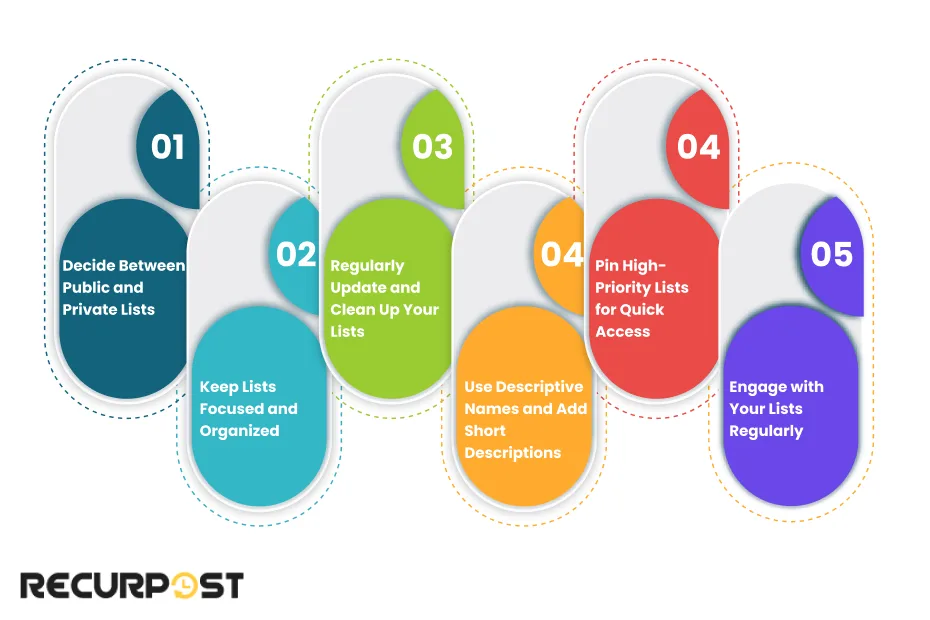
1. Decide Between Public and Private Lists
Not every Twitter list should be public. Public lists are great for showcasing industry leaders, brand advocates, or content curation that benefits your followers. But if you’re tracking competitors, leads, or sensitive groups, make a private list.
This way, only you can see it, and the people on the list won’t know they’re being monitored. Think of it as a strategic way to stay informed.
2. Keep Lists Focused and Organized
Avoid cluttering your lists by keeping them purpose-driven. For example, instead of lumping all clients or influencers together, try breaking them into smaller lists like “Local Clients” or “Marketing Influencers.” This keeps your lists easy to navigate, so you’re not scrolling through dozens of unrelated accounts.
3. Regularly Update and Clean Up Your Lists
Lists aren’t “set it and forget it.” Over time, some accounts might go inactive, change focus, or become irrelevant. Managing Twitter lists requires users to review lists monthly for inactive accounts, where Twitter list management involves organizing lists by specific purposes while maintaining focused membership that aligns with current business objectives. Keeping lists fresh ensures they stay useful and focused on your current needs.
4. Use Descriptive Names and Add Short Descriptions
Naming your lists clearly helps you and others (if the list is public) understand their purpose. Instead of vague names, use specific titles like “NYC Startup Founders” or “Content Marketing Experts.” If you’re making a public list, add a short description so followers know why it’s worth checking out.
5. Pin High-Priority Lists for Quick Access
Twitter lets you pin lists to the top of your Lists section, making it easy to access your most important lists. Whether it’s your client list or industry news feed, pinning helps you keep key lists right at your fingertips. It’s a simple hack that can save time, especially if you manage multiple Twitter lists.
6. Engage with Your Lists Regularly
A Twitter(X) list isn’t just a passive feed. To get the most out of it, engage with the tweets in your lists by liking, retweeting, or replying to posts that resonate. This keeps your Twitter account active in relevant conversations and helps build connections with the people on your lists.
Following these best practices can help you maintain organized, effective Twitter lists that bring value to your social media strategy. With a little effort, your lists will stay up-to-date, relevant, and ready to support your goals.
Twitter List Management Checklist
Ready to put everything together? Use this Twitter list management checklist to stay organized and make sure you’re getting the most out of your lists. Whether you’re setting up your first list or optimizing existing ones, this checklist keeps you on track.
Daily Twitter List Tasks
- Check your pinned high-priority lists for new tweets
- Engage with at least 3-5 tweets from your most important lists
- Monitor your lead generation lists for engagement opportunities
- Respond to any notifications from public list additions
Weekly Twitter List Maintenance
- Review list performance and engagement levels
- Add 2-3 new relevant accounts to existing lists
- Check for inactive accounts that need removal
- Update list descriptions if focus has shifted
- Cross-check competitor lists for new insights
Monthly Twitter List Optimization
- Audit all lists for relevance and purpose
- Remove inactive or off-topic accounts
- Create new lists based on emerging needs or trends
- Review public vs. private list settings
- Update automation rules and monitoring tools
- Analyze which lists drive the most engagement
Quarterly Twitter List Strategy Review
- Evaluate the overall list strategy alignment with business goals
- Archive or delete underperforming lists
- Plan new lists for upcoming campaigns or initiatives
- Review and update list naming conventions
- Assess automation tool effectiveness
- Document lessons learned and best practices
This Twitter list management checklist helps you maintain organized, effective lists that support your social media goals. Print it out, bookmark it, or save it to your notes – whatever works best for keeping your Twitter lists running smoothly.
Conclusion: Making Twitter Lists Work for You
Twitter lists can turn the overwhelming world of Twitter into an organized, focused tool for your brand. Whether you’re managing multiple clients, tracking industry news, or simply connecting with your audience, lists help keep Twitter easy and effective. With a little setup and a few best practices, Twitter lists can boost your brand’s visibility, strengthen connections, and save you a ton of time.
For social media managers, agencies, and small businesses, mastering Twitter lists isn’t just a “nice-to-have”, it’s a way to streamline your social media strategy and make Twitter work for you. So, give Twitter lists a try, and see how they can make your feed more manageable and your brand more connected.
FAQs to Manage Twitter Lists
1. How many Twitter lists can I create?
A Twitter list creator works through the platform’s built-in list creation feature, where Twitter list creators allow users to build up to 1,000 custom lists per account, while each list accommodates up to 5,000 Twitter accounts for organized content curation.
2. Should I make lists public or private?
Public lists are great for visibility and sharing curated content, while private lists are best for tracking competitors or potential leads without drawing attention.
3. Can I add someone to a Twitter (X) list without following them?
Yes! You don’t need to follow someone to add them to a Twitter list, making it easy to keep track of accounts without cluttering your main feed.
4. How do I find Twitter lists created by others?
On a user’s profile, go to the Lists tab to see any public lists they’ve created or subscribed to. You can subscribe to these lists if they’re relevant to you.
5. What are the best tools to manage Twitter Lists in 2025?
The best tools to manage Twitter Lists in 2025 include:
– RecurPost: RecurPost integrates with Twitter lists by providing automation features that schedule content to specific list audiences, track list performance through analytics, and manage multiple Twitter lists from a centralized dashboard.
– Circleboom: Excels in bulk list management with advanced user search capabilities
– Hootsuite: Provides strong monitoring features through custom streams for tracking lists
– TweetDeck: Offers free real-time tracking with a customizable multi-column dashboard
– Tweepi: Specializes in list cleanup and audience growth with inactive account detection

Saurabh Chaturvedi is a content writer at RecurPost. Specializing in social media management and marketing, Saurabh is dedicated to crafting engaging and informative articles. His passion for clear, exciting content keeps readers eager for more.
